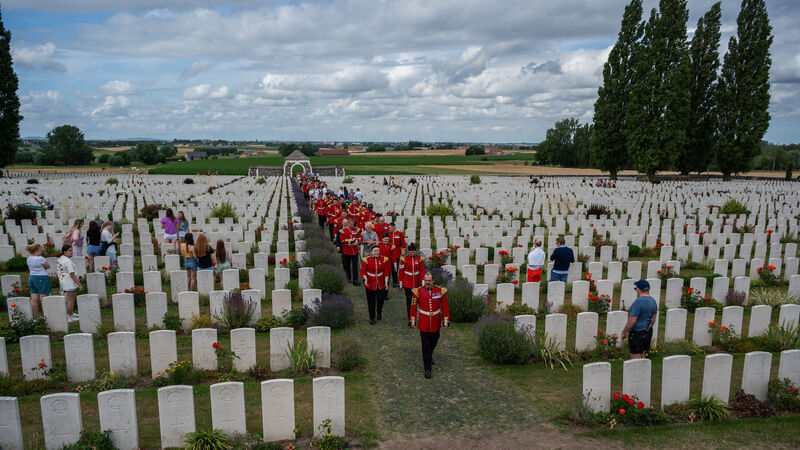30 June 2025
The Menin Gate: Past, Present, and Future
Reopened following an extensive renovation, discover the history and future of the Ypres (Menin Gate) Memorial.
Ypres (Menin Gate) Memorial
“He is not missing: he is here”

Image: The Unveiling of the Menin Gate, July 1927
Sunday 24 July 1927. A breezy, pleasant summer's day greeted thousands of visitors to the historic Flanders city of Ieper.
An important cultural, economic, and military centre for centuries, the ancient city, with its beautiful medieval Cloth Hall, had been devastated by the carnage of the First World War.
Now, with the town undergoing a lengthy, sombre rebuilding, thousands of townsfolk, Great War veterans and their families, gathered to inaugurate a stunning new town landmark: The Ypres (Menin Gate) Memorial.
Crowds lined the ramparts and streets. Loudspeakers boomed the speeches from attending dignitaries to Ieper’s old market square. Over wireless, the BBC broadcast the ceremony across the British Empire.
To deliver the keynote address and officially open the memorial, Field Marshal Herbert Plumer delivered a moving speech, highlighting the purpose of the newly unveiled Menin Gate memorial:
“The hearts of the people throughout the Empire went out to them and it was resolved that here at Ypres, where so many of the missing are known to have fallen, there should be erected a Memorial worthy of them which should give expression to the Nation’s gratitude for their sacrifice and their sympathy with those who mourned them.
"A Memorial has been erected which, in its simple grandeur, fulfils this object, and now it can be said of each one in whose honour we are assembled here today:
“’He is not missing: he is here!’”
And so the bittersweet ceremony concluded with the buglers of the Somerset Light Infantry sounding the Last Post and a sad lament by the pipers of the Scots Guards.
The Last Post has continued to sound every night under the memorial’s solemn arches ever since.
What is the Menin Gate?

Image: The (Ypres) Menin Gate stands over the Menin Road, one of the routes to the battlefields of the Ypres Salient
The Ypres (Menin Gate) Memorial, shortened to Menin Gate, is a Commonwealth War Graves Memorial dedicated to missing servicemen of the First World War.
It stands astride the Menin Road in Ieper, down which hundreds of thousands of Allied troops marched towards the bloody battlefields of the Ypres Salient (Ypres was how Ieper was styled at the time of the First World War).
The Ypres Salient was the site of some of the war's most infamous battles. No less than four major battles took place in and around the city. The most well-known of these is probably the five-month titanic clash, known as The Third Battle of Ypres, commonly referred to as Passchendaele.
Ypres was a strategically important prize, with road and rail links connecting it to the Channel ports. The city lay directly in the path of the Imperial German Army’s advance in 1914. As the war continued, Ypres remained strategically important but never fell to the Germans.
By the end of the war, more than 200,000 men of the British Empire, Belgium, and France, and as many Germans, had died on Ypres’ battlefields.
How many people does the Ypres (Menin Gate) Memorial commemorate?
The Menin Gate commemorates by name over 54,000 officers and enlisted men of the British Empire who died in the Ypres Salient with no known war grave.
These names, carved into monumental stone panels, represent men from five Commonwealth nations: Great Britain, Canada, Australia, Undivided India, and South Africa.
Notably, New Zealanders are not commemorated here. Although New Zealanders fought with distinction in the Ypres Salient, the country’s government decided to erect memorials to its missing war dead near where they died instead.
Lieutenant Euan Lucie-Smith
 Image: Lieutenant Euan Lucie-Smith
Image: Lieutenant Euan Lucie-Smith
One of the notable casualties commemorated on the Menin Gate Memorial is Jamaican-born Euan Lucie-Smith. Lieutenant Lucie-Smith holds the sad distinction of being one of the first British officers of mixed background to die in the First World War.
Son of Jamaica’s postmaster, Euan joined the Royal Warwickshire Regiment shortly after the war began. He arrived in England in 1914, trained on the Isle of Wight, and joined his regiment on the Western Front on 17 March 1915.
He was killed in action just over a month later, on 24 April 1915, during an attack near St. Julien in Flanders. The Royal Warwickshire war diary reported: “Our casualties were very heavy: 17 officers, 500 other ranks, killed, wounded, or missing.”
Lucie-Smith was listed as “Missing, probably killed.”
An eyewitness later reported Euan had been shot in the head. By the time of his death, he had achieved the rank of Lieutenant, making him one of the first black officers in British military history.
Over 200 stories like Euan's have been preserved in the For Evermore: Stories of the Fallen digital archive. With over 54,000 names on the Menin Gate, countless stories remain untold.
When was the Menin Gate built?

Image: The Menin Gate takes shape sometime in the mid-1920s
From design to construction, the Menin Gate took around five years to build.
Sir Reginald Blomfield, one of the Commonwealth War Graves Commission’s original Principal Architects, designed the Menin Gate.
It is based around a long barrel-vault with a pair of triumphal arches at each of the east-west entrances. Roof-mounted oculi allow shafts of light to spill into the Main Hall where the names of the fallen are commemorated in stone.
You will notice lion sculptures adorning the memorial with somewhat forlorn and mournful expressions.
The lion was chosen to symbolise the British Empire, as well as the Lion of Flanders, the region’s traditional heraldic animal. Together, they form a symbolic visual link between the UK and Belgium, with the two nations' wartime experience inextricably linked forevermore.
Since it was opened that sunny July day in 1927, The Menin Gate has become one of the most iconic and enduring Commonwealth War Graves memorials to the missing in the world.

Want more stories like this delivered directly to your inbox? Sign up for our newsletter for regular updates on the work of Commonwealth War Graves, blogs, event news, and more.
Sign UpRestoring the Menin Gate Memorial

Image: 100 years after the first cranes towered over the Menin Gate, they returned during the memorial's extensive restoration
Beginning in April 2023, the Menin Gate underwent a major €6,000,000 restoration, revitalising this magnificent structure after nearly a century standing proudly in Ieper city centre.
The restoration was funded by the CWGC, with contributions from its six member nations – Australia, Canada, India, New Zealand, South Africa and the United Kingdom – proportional to their identified casualties from both world wars. The Flemish Government also provided a €1.6 million grant through the Heritage and Tourism programme, and the City of Ypres supported the project with a €300,000 subsidy.
Restoration works are now finished. The Ypres (Menin Gate) Memorial is ready to withstand another hundred years and more thanks to the brilliant work of our restoration partners and maintenance teams.
Why was the Menin Gate restored?
Long-term preservation.
Our teams have taken enormous pride in caring for this beautiful memorial, but over the decades, the original stone and brickwork have started to feel the effects of time and nature.
The Menin Gate has withstood baking suns, driving rains, snow blankets and the touch of frost, and the effects of pollution. With the thorough restoration, it will be able to contend with the elements for many years to come.
How was the Menin Gate restored?

Image: From masonry and brickwork, lighting, and a new eco roof, the Menin Gate has been comprehensively restored from top to bottom
Over 30 workers worked each day for the duration of this long, complex project. The restoration began in April 2023 and was concluded by the summer of 2025.
An international team, spearheaded by our teams in Belgium, led the project, made up of stonemasons, architects, health & safety experts, project leaders, roofing teams and horticultural specialists.
More than 500 repairs to the memorial were made during restoration. Masonry and brickwork was repointed, repaired, and cleaned where necessary, including repairs to the roof and oculi. Sculptures were touched up too, giving the gate’s expressive stone lions a new lease of life.
You may notice some bumps and bullet holes still remain in the stone. These were taken during the Second World War during the British Army’s retreat from Flanders in the wake of the Wehrmacht’s invasion of France and the Lowlands.
Unless they were too deteriorated, we chose to not to restore these unique features. They’re a part of the memorial’s long history and show its connection to not one but two World Wars.
The all-important name panels were thoroughly inspected and refreshed, too. Remarkably, only two of the over 1,200 needed replacing!
Waterproofing of the roof and basement will protect the memorial from the adverse effects of rain and potential flooding. Internally, metal staircases leading to the roof were removed, restored and reinstalled.
These are not for public access but will make it safer and easier for maintenance teams to access the roof if necessary.
New lighting and audio systems have been installed too to give users a better visitor experience.
Sustainability & the Menin Gate

Image: The Menin Gate's new green roof under construction, just one of the many sustainable measures we've taken to ensure the Menin Gate can continue to commemorate the dead of the Great War in perpetuity
We are charged with caring for the cemeteries and memorials commemorating the Commonwealth’s war dead in perpetuity. Sustainability is at the core of our maintenance and horticultural work.
We applied our sustainability principles during the Menin Gate restoration.
One of the key features of the refreshed Menin Gate is its amazing living roof. A living roof, also known as a green roof, is a roof system where vegetation covers a structure.
This vegetation-covered roof will enhance the longevity of the monument, support biodiversity, improve air quality, and optimise rainwater drainage.
In accordance with our sustainability practices and philosophy, as much recycled natural stone as possible was used for restoration. New stone was only used if absolutely necessary.
UNESCO World Heritage Status
In 2024, UNESCO awarded 151 cemeteries and memorials across the former battlefields of France and Belgium World Heritage Status. 51 of the selected sites are cared for by the Commonwealth War Graves Commission, including the Menin Gate.
So, what does that mean? UNESCO World Heritage status is given to cultural or natural places around the world considered to be of “outstanding universal value”.
The Menin Gate’s immense symbolic value as a permanent memorial to the Great War's Commonwealth fallen endows it with significant cultural and historical importance. It's no wonder it was chosen for UNESCO World Heritage status.
We are bound by UNESCO to specific conservation and maintenance protocols on our inscribed sites, like the Menin Gate. Our practices fall in line with UNESCO requirements, as the stunning restoration shows.
A Royal Reopening

Image: Her Royal Highness The Princess Royal at the 2017 Armistice Day ceremonies held at the Ypres (Menin Gate) Memorial
Her Royal Highness The Princess Royal, President of the Commonwealth War Graves Commission and HRH Princess Claire of Belgium will formally re-open the Menin Gate memorial and unveil a newly engraved stone that marks the inscription of the Menin Gate as a UNESCO World Heritage site.
Their Royal Highnesses will also open the newly refurbished CWGC Ieper Visitor Centre and tearoom, located beside the Menin Gate. The centre deepens public connection, both war remembrance and the rich heritage of Flanders Fields, shaped by the devastation of First World War trench warfare.
Her Royal Highness has previously visited the Menin Gate in 2017 for Armistice Day ceremonies in the year that marked the 100th anniversary of the titanic Battle of Passchendaele.
Looking to the future
With this restoration, The Ypres (Menin Gate) Memorial will continue to stand proudly in the heart of Ieper for decades to come.
Now, our maintenance teams in Belgium will do as they do at all our sites across the country: carefully monitor the Menin Gate for issues and lovingly care for the great structure as they have done for nearly a century.
Visit Commonwealth War Graves in Ieper
Our Ieper visitor centre stands at the heart of commemoration in Belgium, directly across from the Menin Gate. It forms the perfect starting point when visiting the WW1 battlefields and the cemeteries and memorials where those who fell are today commemorated. Our multilingual team are on hand. You can:
- Discover more about our cemeteries and memorials in Ieper and the work of our teams in Belgium and around the world.
- Enjoy some relaxing refreshments in the cosy surroundings of our brand new tea house Blomfield’s.
- Purchase souvenirs from our gift shop. All proceeds are directly invested in our educational and outreach projects worldwide.
- Purchase your biodegradable wreath – we can even keep it safe for you until the Last Post.
- Undertake research on the CWGC database – you can discover if we commemorate your relative or let us assist you with a research project and help find the graves you’re looking for.
Join a guided tour of the Menin Gate - learn more about the iconic memorial and discover some of the stories of the Commonwealth casualties commemorated there.

